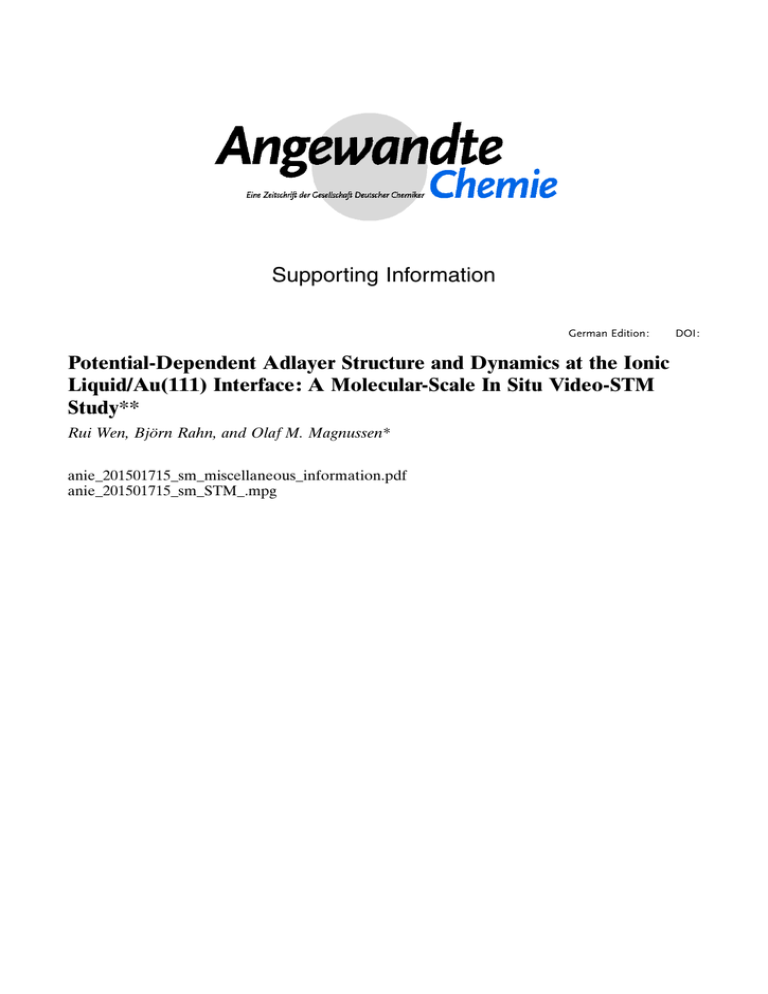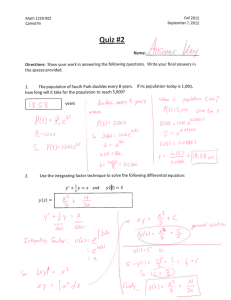Supporting Information
advertisement

Supporting Information German Edition: Potential-Dependent Adlayer Structure and Dynamics at the Ionic Liquid/Au(111) Interface: A Molecular-Scale In Situ Video-STM Study** Rui Wen, Bjçrn Rahn, and Olaf M. Magnussen* anie_201501715_sm_miscellaneous_information.pdf anie_201501715_sm_STM_.mpg DOI: Supporting Information Experimental Section A home-build Video-STM was used for in situ measurement under potential control.[1] For the STM measurements W tips coated by polypropylene (PP) were used. Video STM experiments were performed in “constant height” mode. The water and air stable hydrophobic [BMP][TFSA] was purchased from IOLITEC in highest available quality, and was used after drying under vaccum at 100 °C for 12 hours to reduce the water content. The storage of the RTIL, assemble of the electrochemical cell, and voltammetric measurements were performed with a commercial electrochemical work station (Compactstat, Ivium Technologies) in an Arfilled glove box (LABstar glove box, MBRAUN Company; O2< 1 ppm, H2O < 2 ppm). The Au(111) single crystal (Mateck) was flamed annealed in a butane flame before using, followed by immediate transfer into the glove box to avoid contamination. The RTIL was held in a home-made electrochemical cell, sealed by a Teflon O-ring. After assembling in the glove box, the electrochemical cell was immediately transferred into a dry and enclosed Faradic box for Video-STM measurements. The water content was ca. 225 ppm by Karl Fischer analysis after the Video-STM measurement. The potentials for the electrochemical and the STM measurements are all referred to a Pt quasi-reference electrode. All STM images were treated using the WSxM program (www.nanotec.es). Cyclic voltammetry To get more information about the electrochemical processes, CV with varying switching potentials was performed. When the scan is reversed at -1.28 V, the oxidation peak A2 at -1.18 V couldn’t be observed (the red curve), which means this peak is correlated with the peak C2 at -1.5 V. When the scan is reversed only at -0.75 V, the oxidation peak A1 at -0.19 V disappeared (the blue curve), indicating A1 is correlated with the peak C1 at -1.32 V. Figure 1. Representative cyclic voltammograms in [BMP][TFSA] recorded on Au (111) with different reversal potentials at a scan rate of 10 mV / s. Video-STM observations and data analysis The in situ Video-STM studies of the [BMP][TFSA] / Au(111) interface structure typically commenced near the ocp, followed by potential changes in negative direction. At potentials positive of -1.0 V the images were unstable and “noisy”. This may be caused by a high surface mobility in this regime as well as by problems with the STM measurements. Previous studies of this system by conventional in situ STM reported a very rough surface morphology in this regime.[2] The latter would cause severe imaging problems in the “constant height” mode employed for Video-STM operation. Stable images, resolving terraces and atomic steps, could only be obtained at potentials of approximately -1.0 V or lower. This again is in agreement with Ref. [2] , where substantial surface smoothening was reported after the potential was changed below -1.0 V. At even lower potentials (≤ -1.4 V) the characteristic double-row structures of the Au(111) (√3 × 22) surface reconstruction could be observed by Video-STM in some surface areas (Figure S1a). Formation of this reconstruction on the negatively charged surface was reported also for 1-butyl-1-methylpyrrolidinium tris(pentafluoroethyl)trifluorophosphate ([BMP][FAP]).[3] Contrary to the latter system, however, the Au surface does not reconstruct completely in [BMP][TFSA], Instead, only isolated reconstruction elements are formed, while major surface areas apparently remain unreconstructed. Furthermore, the hexagonal lattice of the Au(111) surface atoms could be observed in rare cases (Figure S1a, inset). Figure S1. In situ Video-STM images of Au(111) in [BMP][TFSA] at -1.4 V, showing (a) the Au surface reconstruction (15 nm × 19 nm) as well as (in inset) the Au(111) atomic lattice (1.0 nm × 4.4 nm) and (b) the (√13 × √3) adlayer of [BMP] + ( 2.7 nm × 4.9 nm). These observations of the Au substrate assist the structural analysis of the [BMP]+ adlayer. Specifically, the adlayer orientation could be determined by direct comparison with the orientation of the Au reconstruction in images recorded subsequently in the same experiment, revealing that the molecular rows along a1 are parallel to the <121> direction of the underlying Au (111) lattice (Figure S1b). Furthermore, they provide an internal calibration in determining the lattice parameters. The remaining experimental errors in the determination of the intermolecular distances from the STM images are typically ±0.05 nm, those in the determination of the angles ±2°. The detailed interpretation of the STM images is hampered by the lack of knowledge on the STM contrast mechanisms in this environment, which for RTILs is even less understood than for STM measurements in aqueous electrolyte solutions. Furthermore, this interpretation is even more difficult for Video-STM, which requires measurements in “constant height” mode, where the image contrast stems from the measured tunneling current. The latter depends in a non-linear way on the local tip-sample distance and (at large distances) may even become too small to contribute. For this reason, the Video-STM contrast decays in lower lying surface areas, e.g. on the bottom terrace visible in Figure SI_1a. We attribute the ordered molecular structures observed in our in situ Video-STM studies to [BMP]+ in the innermost layer, i.e., molecules that are in direct contact with the metal surface and thus bound particularly strongly.[3b, 4] Although it is not possible to directly deduced this from the appearance of these structures in the images, the rather high tunneling currents used in this study and the correspondingly low tip-sample distances make this assignment most likely. Because the ordered structures exhibit a well-defined epitaxial arrangement with respect to the Au(111) lattice, the adlayer order has to originate from the interaction of the RTIL with the electrode and thus has to be present in the layer directly adsorbed on the Au surface. Probably, this lateral order propagates at least partly into the subsequent layers near the electrode. We therefore cannot unambiguously exclude that these layers, especially coadsorbed (anion) species in the second layer, contribute to the contrast in the STM images. However, this would not affect the conclusions of our discussion on the innermost adlayer structure. [1] [2] aO. M. Magnussen, L. Zitzler, B. Gleich, M. R. Vogt, R. J. Behm, Electrochimica Acta 2001, 46, 3725-3733; bT. Tansel, O. M. Magnussen, Physical Review Letters 2006, 96. R. Atkin, S. Z. El Abedin, R. Hayes, L. H. S. Gasparotto, N. Borisenko, F. Endres, Journal of Physical Chemistry C 2009, 113, 13266-13272. [3] [4] aR. Atkin, N. Borisenko, M. Drueschler, F. Endres, R. Hayes, B. Huber, B. Roling, Journal of Molecular Liquids 2014, 192, 44-54; bR. Atkin, N. Borisenko, M. Drueschler, S. Z. El Abedin, F. Endres, R. Hayes, B. Huber, B. Roling, Physical Chemistry Chemical Physics 2011, 13, 6849-6857. R. Hayes, N. Borisenko, M. K. Tam, P. C. Howlett, F. Endres, R. Atkin, Journal of Physical Chemistry C 2011, 115, 6855-6863.




